Is the old reputation of diesel engines as smelly, noisy, and slow dead yet? These engines are very popular in Europe (partly due to tax incentives) and among professional car reviewers (partly because they're not the norm), but haven't yet caught on with North American car buyers (allegedly because that old rep dies hard).
BMW gave a go at changing this rep with the 265-horsepower, 425 lb-ft-o-torque six-cylinder 335d a few years ago. It didn't sell. A starting price $4,000 above the 335i (and $10,000 above the 328i) didn't help. But buyer interest in a high-performance diesel was clearly less than vigorous.
For 2014, BMW is giving diesel a second chance in North America, with a different strategy. This time around the engine has two-thirds as many cylinders and two-thirds as much power and torque (180 and 280, respectively). The 328d's EPA ratings are much higher (32 mpg city, 45 mpg highway vs. the 335d's 23 / 36) and its base price is significantly lower ($39,325 vs. $45,025). This lower price is still $1,500 above that of the 328i, but is $4,600 below that of the 335i. This puts the 328d in the thick of what people typically pay for a BMW 3-Series. Plus, unlike last time, all-wheel-drive is an option.
The 328d has no direct competitors. Mercedes offers the only other four-cylinder diesel available in an upscale sedan on this side of the Atlantic, in the somewhat larger, more-than-somewhat more expensive E250. If you want a wagon, even the Benz alternative goes away. But the 335d also had no direct competitors, and we're not getting that one again (it has continued to be offered in Europe).
The big question: can a four-cylinder diesel deliver the driving experience people expect from a BMW, plus such good fuel economy that North American luxury car buyers (who are increasingly interested in saving the planet through their automotive choices) will consider it?
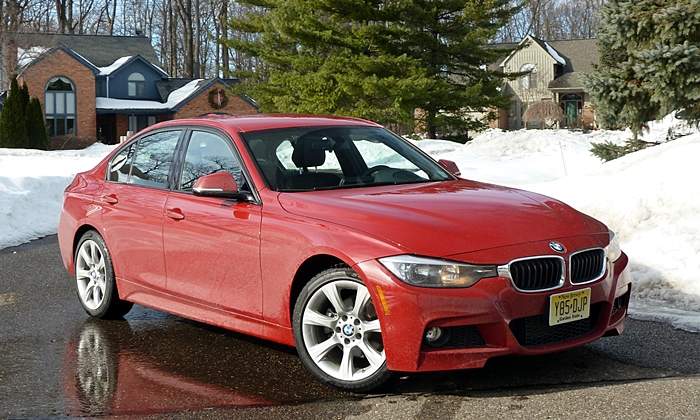
Unfortunately, far too cold to wash the car. Looks much larger than previous 3ers (because it is). more 3-Series photos
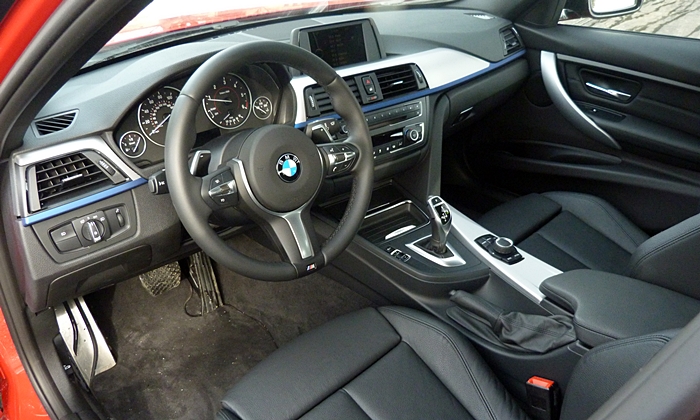
Typically technical BMW styling inside as well. Blue trim strip is only on IP, not doors. Why?
| |
Compared to the E-Class |
| Fuel economy |
 Better
Worse
Better
Worse
|
Both the tested BMW 328d and the tested Mercedes-Benz E250 BlueTEC were fitted with optional all-wheel-drive (AWD) systems. This cost them an mpg or two, but kept the playing field level.
The more compact BMW weighs much less, 3,620 vs. 4,409 pounds, and has an engine tuned to produce considerably less peak torque (280 vs. 369 lb-ft) and a bit less peak horsepower (180 vs. 195), so it shouldn't come as much of a surprise that it earns a significantly higher EPA city rating, 31 vs. 27 mpg. But on the highway the Benz nearly bridges the gap, 43 vs. 42 mpg. (All figures here with AWD. With rear-wheel-drive the cars rate 32/45 and 28/45.)
Diesel enthusiasts argue that the EPA's testing regimen penalizes the compression-ignition engines, and that real world figures tend to be higher.
Unfortunately, I drove the two cars on much different roads under much different conditions. In straight 65-mph highway driving in balmy temps, the Mercedes-Benz's trip computer reported averages in the low 40s, very close to the EPA rating. On a fairly aggressive drive in the hills south of San Francisco, this average dropped to 28, which is still better than the EPA city rating. And on a cruise along one of the less curvy portions of the California coastal highway it managed a two-way average around 39. Not too shabby for such a heavy car.
I drove the BMW 328d in suburban Detroit during some especially cold weather (thank you, polar vertex), which harms fuel economy. Even so, with a fairly heavy foot and a cold start it managed 33 mpg while driving my son the eight miles to his school. On the way back, with a lighter right foot and a warm engine, it managed 44. The highest observed average was 49. At a steady 65 miles-per-hour on the highway the trip computer reported just under 40 mpg. Correct for the much colder temperature, and this is at least as good as the Mercedes, but a much tighter race than in around-town driving.
My initial impression was that the 328d's trip computer reports weren't much better than the gas-powered 328i's surprisingly good numbers. Then I checked my review. Even though the 328i wasn't penalized by all-wheel-drive, and the ambient temperature wasn't quite as low, its averages were between two-thirds (moderately heavy foot) and four-fifths (ultra-light foot) as high as the 328d's. Overall, figure three-quarters as efficient, at best. Impressive for a quick, gas-powered car, but no match for the diesel, even considering that diesel tends to cost more than premium gasoline (this varies by local area).
| Front seat support & comfort |
 Better
Worse
Better
Worse
|
Same front seats as in the 335i Gran Turismo reviewed last week. Same thing to say about them...
Why anyone buys a BMW in base or Luxury Line trim escapes me. The seats in those cars are flat and provide little lateral support. The sport buckets included in the Sport Line and M Sport Line (tested) are both more comfortable when cruising and much more supportive when the road curves. Their side bolsters can be adjusted to fit torsos of varying breadth.
The $660 "Active Multicontour Driver Seat" in the E-Class performs a couple of additional tricks. The bolsters can be set to automatically motor inwards when the steering wheel is turned. Though rather silly when this occurs in a parking lot (the programming should take vehicle speed into account), it's reassuring, even encouraging, when flogging the car along a twisty road. Meanwhile, you can be receiving one of four levels of massage (slow and gentle, slow and vigorous, fast and gentle, or fast and vigorous).
This would be "advantage Mercedes," except that only the driver seat gets these features. Your passenger will be happier (both with the adjustable bolsters and the more equitable treatment) in the BMW.
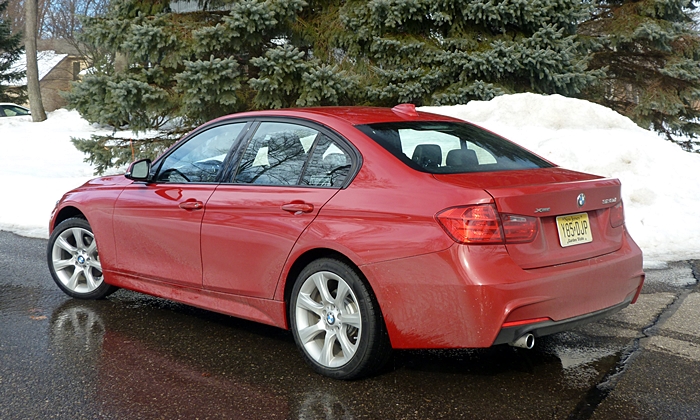
The roof line, though not coupe-like (4 Gran Coupe for that), is less formal than the Benz's.
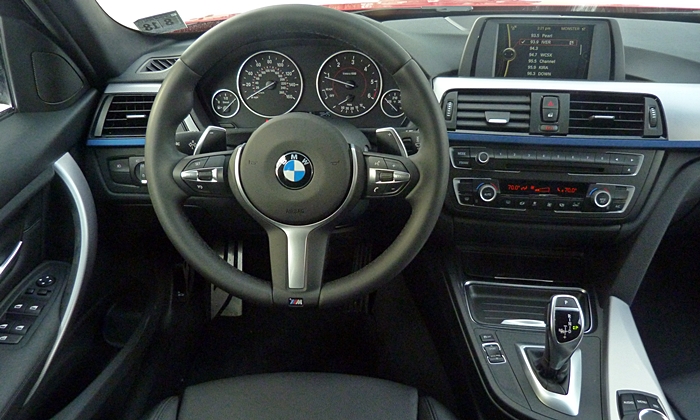
Somewhat idiosyncratic controls mostly easy to use--once you learn how they work.
| Rear seat room & comfort |
 Better
Worse
Better
Worse
|
The BMW 3-Series used to be tight inside, but it has grown with each redesign, especially the most recent one. The rear seat of the current sedan isn't nearly as roomy as that in the related 3-Series Gran Turismo hatchback. But it offers considerably more rear legroom than direct competitors like the Audi A4, Cadillac ATS, and Mercedes-Benz C-Class. In fact, combined front and rear legroom is the same as in the one size-class up, ten-inch-longer Mercedes E-Class. (You do get a half-inch more rear headroom and nearly two inches more rear shoulder room in the Benz.) Beyond the specs, the BMW's rear seat is comfortably high off the floor, a rarity in the age of sedans with plunging coupe-like roof lines.
| Cargo capacity |
 Better
Worse
Better
Worse
|
The trunk of the BMW 3-Series also grew a lot with the latest redesign, to 17 cubic feet, making it easily the largest in the segment, and even a bit larger than that in the one-size-up Mercedes E-Class. A practical BMW, who expected this? One controversial enabler: no spare tire is offered.
| Handling |
 Better
Worse
Better
Worse
|
Mercedes tweaked the suspension of the E-Class as part of its mid-cycle upgrades for 2014, and the new E250 (in Sport form) handles quite a bit better than an E550 I tested a year ago. The revised car feels much more balanced in hard turns, and maintains its composure better when the road surface gets a bit lumpy. (I can't speak to what happens when the road gets a lot lumpy, as I tested the E250 in California.) But the steering of the E-Class remains far too light for anyone who cares to feel the road.
Though the Mercedes has gotten more talented, and the BMW has grown softer (to the point that body motions can feel poorly controlled with the base suspension), the latter remains the better-handling car. In sport mode (you can also select Comfort and EcoPro), the 328d M Sport Line's steering has a more reassuring heft to it and its (optionally) adaptive damper-equipped chassis feels more tied down when driven at speed across dips and rises. (Even when fitted with its sports suspension the Mercedes can float a little.) As with virtually all BMWs, the harder you can push the 328d the better it feels.
I haven't placed handling higher in the list of "why to buys" because the latest 3-Series isn't as involving or as enjoyable to drive as past 3-Series, or even as some current direct competitors like the Cadillac ATS and Lexus IS. The electrically-assisted steering might be well-weighted, but it provides little in the way of feedback. Especially when fitted with all-wheel-drive (as the tested 328d was) the sedan feels a touch nose-heavy and even a little reluctant to change directions.
So why have handling among the pros at all? Well, I'm reviewing the 328d here, and there are no other diesel-powered sedans in the segment. There are a couple the next segment up, notably the E250 and the Audi A6, but a larger, heavier car never feels as agile as a smaller, lighter one. So if you are only considering diesels, the 3-Series is the best-handling of the small bunch.
| |
Compared to the E-Class |
| Quietness |
 Better
Worse
Better
Worse
|
Drive an Audi A6 TDI, and you can barely tell that its 3.0-liter V6 engine is a diesel at idle, and probably cannot tell at all otherwise. Its smooth and the little noise you do hear doesn't give the means of combustion (i.e. compression rather than ignition) away.
It's harder to hide the true nature of the beast with just four cylinders. The new 2.1-liter engine in the Mercedes-Benz E250 makes more noise than the V6 in an Audi, and this noise is more readily recognizable as that of a diesel. But the sound quality isn't objectionable, even in a $60,000+ sedan.
The BMW 328's 2.0-liter is considerably noisier than the slightly larger four-cylinder engine in the Mercedes, and its chugging and gargling is much more easily recognizable as that of a diesel. Perhaps this should come as no surprise, as even BMW's gas-powered four-cylinder engine sounds somewhat diesel-like when idling and at low rpm. But I am nevertheless shocked that engine-master BMW didn't turn out a much more refined enigne.
To be fair, it's not just a matter of the engine. I wouldn't mind this engine in a less expensive car with a less sporting mission. But an ultimate driving machine should have a smoother, more pleasant-sounding engine that is much more willing to rev. As it is, even the engine in the E250 is much more enjoyable to exercise along a winding road.
Aside from the engine, noise levels in the 328d are fairly low.
There's some road noise inside the Mercedes when driving on a concrete highway, but in general it insulates occupants more thoroughly from the outside world than the BMW does--as a larger, heavier, more expensive car should. The BMW 5-Series, for 2014 available in six-cylinder diesel 535d form, would be more of a match for the Mercedes in this regard.
| Ride smoothness |
 Better
Worse
Better
Worse
|
Even when fitted with a sport suspension (highly recommended for the body control benefits noted earlier) the BMW 328d doesn't ride badly, only getting a little bumpy on the badly frost-heaved roads of post-polar vortex metro Detroit. It's not clear that the adaptive dampers in the Dynamic Handling Package help much. In Comfort the suspension permits a little too much body motion, while in Sport the bumps can have a slight kick to them as the run-flat tires thump across them. The standard sport suspension could strike a better balance between the two settings--I'd try to test drive cars with both on the roads you typically use before buying.
The thing is, while the 328d's ride is okay, the E250's is excellent. The Mercedes glides over the worst road perfections I encoutered in California. It feels like a more substantial car than the BMW, in part because it is a more substantial car. Those 800 additional pounds (4,409 vs. 3,620) go towards more than just an extra ten-inches of length. Given the differences in ride and interior sound quality, the E250 is the clear choice in this pair for those seeking a serene cruiser.
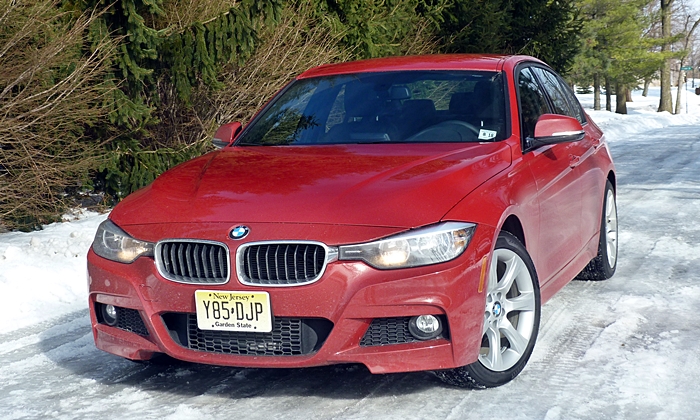
For $1,000 over the Sport Line, the M Sport Line adds this more aggressive lower front fascia.
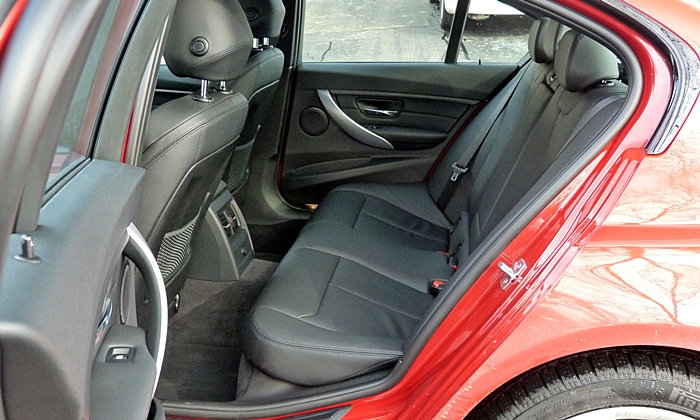
Rear seat roomier than people expect from a 3-Series. Legroom matches E-Class.
| Interior styling |
 Better
Worse
Better
Worse
|
Another category that can be lifted straight from the 3 GT review...
Munich has softened the cars up in many ways to broaden their appeal, but the interior styling of the 3-Series remains coldly technical, especially the area directly in front of the driver. If this atmosphere appeals to you, then by all means move interior styling out of the "why not" column, maybe even to the "why" column. But many people will be turned off by it. For them, the glitzier, more lavishly trimmed Mercedes interior (which both looks and feels more expensive) will have more appeal.
| |
Compared to the E-Class |
| Exterior styling |
 Better
Worse
Better
Worse
|
Both the 328d and the E250 are readily identifiable as a BMW 3-Series and a Mercedes-Benz E-Class, respectively. Both makes have slowly evolved the styling of their cars over the decades, and they're least likely to try anything risky with these core products.
The upside is that the 328d is a handsome, well-proportioned car. The downside is that there's nothing new or especially interesting to see here. I personally preferred the more adventurous, more aggressively creased lines of the 2006-2011 3-Series even if some styling elements were less timeless.
This said, comparing the current cars the sleek 3-Series is considerably more attractive than the blocky E-Class. For those seeking something more stylish Mercedes offers the related CLS, but in North American this "four-door coupe" isn't available with a diesel.
| Powertrain performance |
 Better
Worse
Better
Worse
|
The only way the performance of these diesels is likely to disappoint you is if you're expecting them to feel sluggish. Especially in typical around-town driving they feel energetic, even powerful. Credit the torque advantage of diesel engines. While BMW 328i's turbocharged 2.0-liter gas engine can produce 260 lb-ft of torque, 328d's similarly sized diesel can produce 280. You don't have to work this engine hard to merge onto a highway or to squirt ahead and grab a slot in the next lane.
Then there's the Mercedes. While the BMW boosts its engine with a single twin-scroll turbocharger, Mercedes employs two turbochargers, a small one initially (to minimize lag) then a larger one (to maximize boost). With the big turbo spooled up the 2.1-liter engine can deliver a phenomenal 369 lb-ft of grunt. Though it has 800 pounds more mass to motivate, this engine feels even more energetic than the BMW's in typical driving.
I keep saying "in typical driving" because while diesels have an advantage at low to moderate enigne speeds, compared to gas engines they run out of breath much sooner and (thanks to heavier internal parts) cannot spin nearly as high. Even with the go pedal to the floor the 328d's engine shifts at 4,500 rpm, vs. at least 6,500 with the 328i's gas engine. For this reason power peaks at 180 horsepower vs. 240. Run the 328i flat out, and it will get from a standing start to 60 mph about a second-and-a-half sooner. (BMW's official times are 5.8 and 7.4 seconds, respectively.)
The six-cylinder diesel in the 2009-2011 335d was about as quick as the current 328i. But it was also barely more fuel efficient than the 328i.
The engine in the Mercedes E250 doesn't have nearly as large an output advantage over that in the 328d at high rpm. Its 15 extra horsepower can't quite conpensate for the E250's additional curb weight, so it'll take closer to eight seconds to get to sixty. Still much quicker than people with outdated perceptions of diesels will expect, but no match for the gas-powered, 302-horsepower E350.
Bottom line: both diesels perform splendidly in around-town driving. And they serve well on a twisty road where their capable chassis permit most (or even all) of the legal speed to be maintained through curves. But if you crave maximum, foot-to-the-floor, shifting-at-the-redline thrust, gasoline remains the way to go.
| Price or payments |
 Better
Worse
Better
Worse
|
The tested BMW 328d was optioned like few customer-ordered cars will be, with all performance options but no others save red metallic paint and black leather. As such, it lists for $48,525. The tested Mercedes-Benz E250, on the other hand, had virtually every option, including a lane keep assist system that can manage highway curves without the driver, bringing its window sticker to about $70,000.
Equip both cars with sport suspensions and typical options, and the BMW comes to $48,175, the Mercedes to $58,915, a difference of $10,740. Adjust for a few additional features on the E250, and the difference comes to about $9,200. Worth it for the additional solidity and features of the larger car? This depends on your priorities.
The BMW 328d doesn't entirely dispel negative perceptions of diesels. Though quick, the turbocharged 2.0-liter four could be quieter and smoother. Its character isn't a great fit for that of the 3-Series. Beyond the engine, the steering could provide more feedback and the chassis could feel better balanced (doing without AWD would help here).
These shortcomings noted, if you're willing to trade some powertrain refinement and full-throttle acceleration for a 10 mpg bump in fuel economy, then the 328d should be worth its $1,500 additional cost over the 328i. A Mercedes-Benz E250 delivers a more substantial, more luxurious feel, while an Audi A6 TDI might do the same with a more powerful, more refined engine. But these larger cars can't match the agility of the lighter, more compact BMW, and don't offer significantly more rear seat legroom or cargo capacity. In simplest terms, the 328d is the best-handling, lowest-priced, most fuel-efficient diesel sedan offered by a premium brand in North America. If this is what you've been seeking, then here it is.
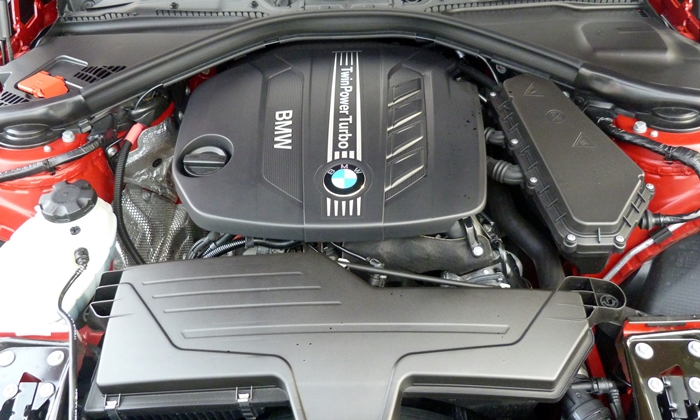
Economical and sufficiently powerful, but short on refinement.
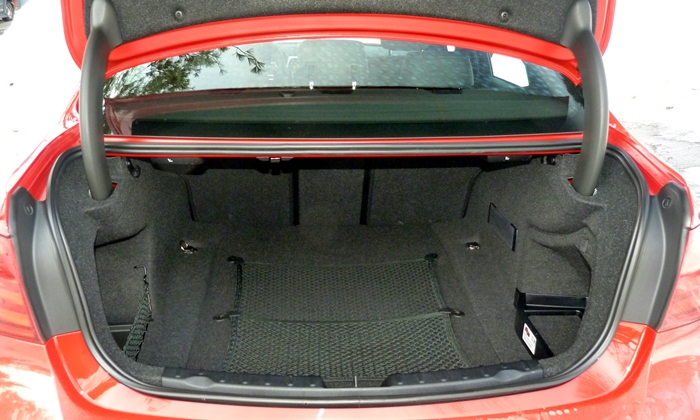
The 328d's trunk is also large for the class.
See more 2014 BMW 3-Series photos
BMW and Mercedes each provided insured cars with a tank of diesel. (I did not come close to using all of either tank.)











